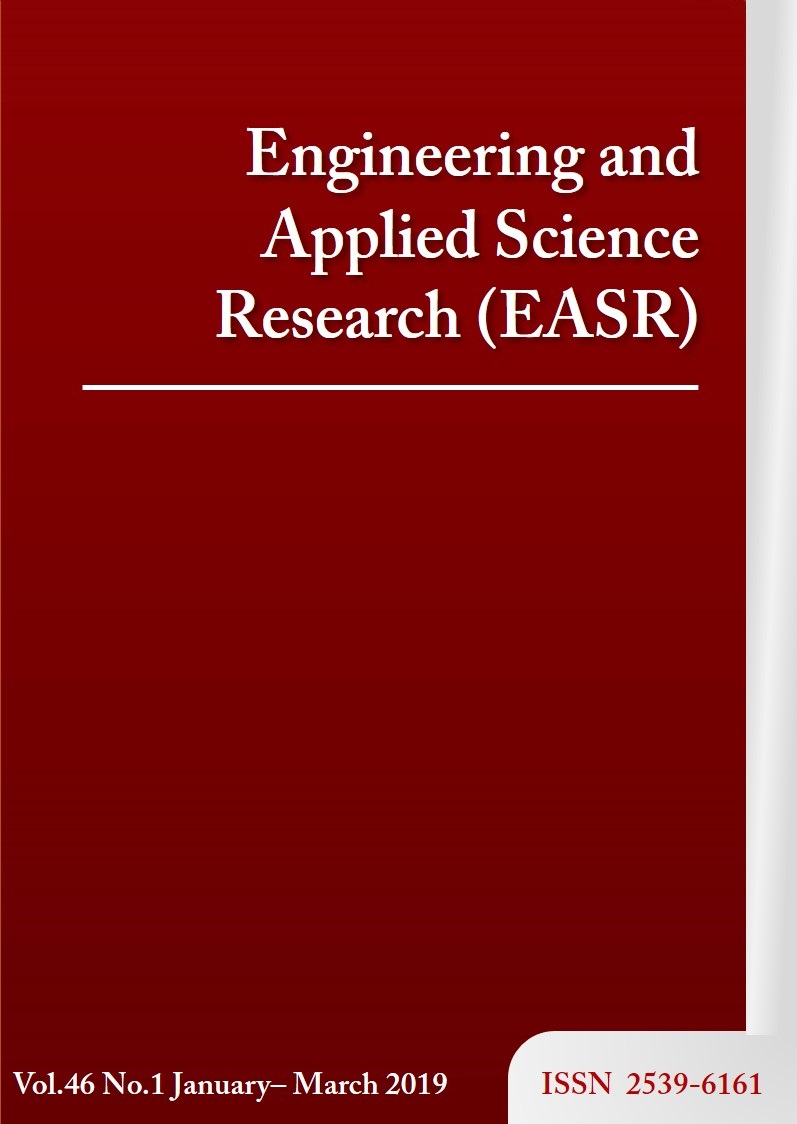Modified interactive strut-and-tie model for shear strength prediction of RC corbels
Main Article Content
Abstract
On the basis of the modified Kupfer and Gerstle’s biaxial failure criterion of concrete, a modified interactive strut-and-tie model (MISTM) to predict the nominal shear strength of RC corbels was derived and is proposed in this paper. The MISTM includes the interaction between the load-carrying capacity of a concrete strut and a tension tie, and the effects of horizontal force. The number of horizontal and vertical stirrups was considered. To validate and calibrate the MISTM, a dataset test results for 302 corbels was collected from the literature. Finally, the predictions obtained from the MISTM were also compared with those computed using the strut-and-tie models in accordance with the ACI 318 code and the state-of-the-art presented in the literature, and are found to be more accurate and reliable.
Article Details
This work is licensed under a Creative Commons Attribution-NonCommercial-NoDerivatives 4.0 International License.
References
[2] Kriz LB, Raths CH. Connections in precast concrete structures-strength of corbels. PCI J. 1965;10(1):16-61.
[3] Mattock AH, Chen KC, Soongswang K. The behavior of reinforced concrete corbels. PCI J. 1976;21(2):52-77.
[4] Yong Y, Balaguru P. Behavior of reinforced high-strength concrete corbels. J Struct Eng. 1994;120(4): 1182-201.
[5] Foster SJ, Powell RE, Selim HS. Performance of high-strength concrete corbels. ACI Struct J. 1996;93(5): 555-63.
[6] Lu WY, Lin IJ, Hwang SJ. Shear strength of reinforced concrete corbels. Mag of Conc Res. 2009;61(10):807-13.
[7] Yang J.M, Lee JH, Yoon YS, Cook WD, Mitchell D. Influence of steel fibers and headed bars on the serviceability of high-strength concrete corbels. J Struct Eng. 2012;138(1):123-9.
[8] Hwang SJ, Lu WY, Lee HJ. Shear strength prediction for reinforced concrete corbels. ACI Struct J. 2000; 97(4):543-52.
[9] Hwang SJ, Lee HJ. Strength prediction for discontinuity regions by softened strut-and-tie model. J Struct Eng. 2002;128(12):1519-26.
[10] Russo G, Venir R, Pauletta M, Somma G. Reinforced concrete corbels-shear strength model and design formula. ACI Struct J. 2006;103(1):3-10.
[11] Yang KH, Ashour AF. Shear capacity of reinforced concrete corbels using mechanism analysis. Struct Build. 2012;165(3):111-25.
[12] Kassem W. Strength prediction of corbels using strut-and-tie model analysis. Int J Conc Struct Mater. 2015; 9(2);255-66.
[13] Hwang SJ, Tsai RJ, Lam WK, Moehle JP. Simplification of softened strut-and-tie model for strength prediction of discontinuity regions. ACI Struct J. 2017;114(5):1239-48.
[14] ACI Committee 318. Building code requirements for structural concrete (ACI 318-14) and Commentary (318R-14). Farmington Hills, USA: American Concrete Institute; 2014.
[15] European Committee for Standardization Eurocode 2 (CEN). Design of concrete structures-part 1.1: general rules and rules for buildings. Brussels, Belgium: European Committee; 2004.
[16] Kupfer H, Gerstle K. Behavior of concrete under biaxial stresses. Eng Mech Div. 1973;99:853-66.
[17] Vecchio FJ, Collins MP. The modified compression field theory for reinforced concrete elements subjected to shear. ACI J. 1986;83(2):219-31.
[18] Zhang LX, Hsu TTC. Behavior and analysis of 100 MPa concrete membrane elements. J Struct Eng. 1998; 124(1):24-34.
[19] Kaufmann W, Marti P. Structural concrete: Cracked membrane model. J Struct Eng. 1998;124(12):1467-75.
[20] Zwicky D, Vogel, T. Critical inclination of compression struts in concrete beams. J Struct Eng. 2006;132(5):686-93.
[21] Chetchotisak P, Teerawong J, Yindeesuk S, Song J. New strut-and-tie-models for shear strength prediction and design of RC deep beams. Comput and Conc. 2014;14(1):19-40.
[22] Chetchotisak P, Teerawong J, Yindeesuk S. Multiple linear regression models for shear strength prediction and design of simply-supported deep beams subjected to symmetrical point loads. KKU Eng J. 2015;42(3): 219-25.
[23] Tang CY, Tan KH. Interactive mechanical model for shear strength of deep beams. J Struct. Eng. 2004; 130(10):1534-44.
[24] Zhang N, Tan KH. Direct strut-and-tie model for single and continuous deep beams. Eng Struct. 2007;29(3): 2987-3001.
[25] Wang GL, Meng SP. Modified strut-and-tie model for pre-stressed concrete deep beams. Eng Struct. 2008; 30(4):3489-96.
[26] Chetchotisak P, Yindeesuk S, Teerawong J. Interactive strut-and-tie model for shear strength prediction of RC pile caps. Comp and Conc. 2017;20(3):329-38.
[27] Arora JS. Introduction to Optimum Design. 4th ed. USA: Academic Press; 2016.
[28] Abdul-Wahab HM. Strength of reinforced concrete corbels with fibers. ACI Struct J. 1989; 86(1):60-6.
[29] Alameer M. Effects of fibres and headed bars on the response of concrete corbels [thesis]. Montreal, Canada: McGill University; 2004.
[30] Campione G, La Mendola L, Mangiavillano ML. Steel fiber-reinforced concrete corbels: experimental behavior and shear strength prediction. ACI Struct J. 2007;104(5):570-9.
[31] Chakrabarti PR., Farahi DJ, Kashou SI. Reinforced and pre-compressed concrete corbels-an experimental study. ACI Struct J. 1989;86(4):132-42.
[32] Clifford C. Performance of lightweight concrete corbels subjected to static and repeated loads [dissertation]. Oklahoma, USA: The Oklahoma State University; 1977.
[33] Cook WD. Studies of reinforced concrete regions near discontinuities [dissertation]. Montreal, Canada: McGill University; 1987.
[34] El-Maaddawy TA, El-Sayed IS. Response of concrete corbels reinforced with internal steel rebars and external composite sheets: experimental testing and finite element modeling. J Compos for Const. 2014; 18(1):1-11.
[35] Fattuhi N, Hughes B. Ductility of reinforced concrete corbels containing either steel fibers or stirrups. ACI Struct J. 1989;86(6):644-51.
[36] Fattuhi N, Hughes B. Reinforced steel fiber concrete corbels with various shear span-to-depth ratios. ACI Struct J. 1989;86(6):590-6.
[37] Fattuhi N. Strength of SFRC corbels subjected to vertical load. J Struct Eng. 1990;116(3):701-18.
[38] Fattuhi N. Reinforced corbels made with plain and fibrous concrete. ACI Struct J. 1994;91(5):530-6.
[39] Fattuhi N. Strength of FRC corbels in flexure. J Struct Eng. 1994;120(2):360-77.
[40] Her GJ. Study of reinforced high-strength concrete corbels [thesis]. Taipei, Taiwan: National Taiwan University of Science and Technology; 1990.
[41] Nagrodzka-Godycka K. Behavior of corbels with external pre-stressing bars-experimental study. ACI Struct J. 1999;96(6):1033-9.
[42] Tan KH, Mansur MA. Partial pre-stressing in concrete corbels and deep beams. ACI Struct J. 1992;89(3): 251-62.
[43] Rulak P. Load transfer mechanisms and softening effect used in conjunction with strut-and-tie model for shear strength prediction of RC corbels [thesis]. Khon Kaen, Thailand: Khon Kaen University; 2016.
[44] Park JW, Kuchma D. Strut-and-tie model analysis for strength prediction of deep beams. ACI Struct. J. 2007; 104(6):657-66.



